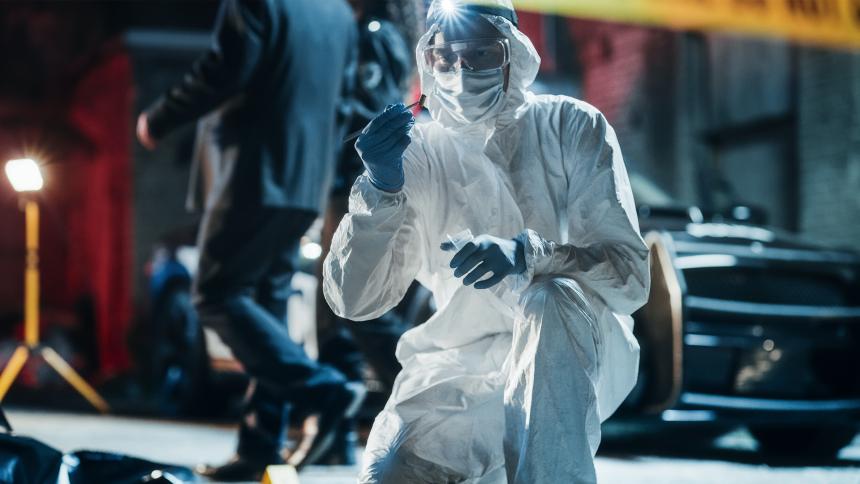
Five areas of forensic investigation
Since the science of fingerprinting was first initiated in 1891 by Argentine police officer Juan Vucetich, the process has evolved into becoming one of the most incontrovertible forms of evidence to be produced in a court of law, particularly after the development of DNA fingerprinting in 1986 by British Professor Alec Jeffreys at Leicester University. Several prominent names feature in the history of fingerprinting, notably Sir William Herschel, British Administrator in India in 1858 who took the unprecedented step to request fingerprints together with signatures on civil contracts as a means of identifying citizens.
Thirty four years later in Buenos Aires, Juan Vucetich’s evidence led to the first successful murder conviction due to fingerprint evidence. This groundbreaking case involved a woman who had murdered her two sons and then cut her own throat in an attempt to place blame on another person but was found to have left bloody fingermarks on a door post at the scene of the crime. Between 1892 and 1895 Victorian statistician Sir Francis Galton not only devised classification of finger marks with varying patterns that is still used today but also identified the individuality and uniqueness of fingerprints. Since then no two fingerprints have been found to be the same in many billions of human and automated computer comparisons.
The role of fingerprinting in collating and collecting evidence and eliminating suspects operates in two very distinctive ways – the discovery of ‘finger marks’ on objects from unknown sources and ‘finger prints’ made by known characters and suspects.
The first incident of using DNA analysis in a criminal case that led to a conviction was that of the rape and murder of two teenage girls three years apart in Leicestershire in 1987 by assailant Colin Pitchfork. Police investigating the crimes contacted Doctor Alec Jeffreys at the University of Leicester and asked for his assistance using his new DNA profiling method to analyse semen on the vaginal swabs from the victims and compare the samples given voluntarily by 5000 men from the surrounding areas. A match revealing the killer’s unique genetic code to Pitchfork led to a watertight conviction for a double murder that had initially stretched the resources of Leicestershire police and the CID.
Doctor Jeffreys’ DNA breakthrough was initially developed to assist paternity and immigration cases but at the time of the murders was then applied in what became the world’s first application of DNA profiling to convict a murderer.
Forensic Podiatry involves the analysis of foot prints at the scene of a crime usually as part of comparison methods and more recently involves ‘gait analysis’ which is the identification of a person or persons by their style or manner of walking. It is these features that can be identified after the images are analysed on CCTV footage by an expert. The technology was first used in 2000 by UK Podiatrist Hayden Kelly when this kind of identification was first admitted in a criminal court.
The perpetrator of the crime had worn a mask, two pairs of trousers and gloves but could not disguise the way he walked. The successful prosecution was the first time Podiatry had been used in forensics in this way and has since evolved into playing a major part in criminal prosecutions resulting in training programmes now offered at Universities around the world. One famous case involving Forensic Podiatry was that of murdered University student Meredith Kercher in Perugia, Italy in 2007 which led to the conviction of one of her killers when a bloody footprint was left on the victim’s bathroom mat.
Similarly with Forensic Footwear analysis the method requires examination of the shoe in question and a reference shoe. A detailed process of the exhibit shoe, analysing impressions, examining distinctive wear and tear and distinctive sole ridges often reveals similar evidence to that of finger print analysis.
Probably not the most appealing vocation for someone with a phobia of creepy crawlies but certainly the study of insects as part of crime+investigations a vital early role in forensic examination. In simplified terms Entomology is about the analysing of insects that feed on the dead body during its decomposing state which normally goes through five stages until final skeletonization.
In a way flies, beetles and arthropods act like silent witnesses to a death and a Forensic Entomologist can determine by their presence not only the time of death but also - depending on the type of insect - the season of death, taking into account that certain species of insects are only active during specific months. As well as establishing the time factor relating to a death Forensic Entomology can also reveal a fascinating insight into the life of the victim before they died. A presence of drugs or indication of a drug lifestyle such as the habitual taking cocaine would result in maggots feeding on affected tissues to develop much faster than they normally would.
Also the presence of insects only found in the city or distant areas of the country would indicate that the body had been moved from where the victim was murdered. Equally if the insect cycle was disturbed it may indicate that the killer returned to the scene of the crime and disturbed the body.
Quite often the public’s main appreciation of Forensic Psychology is through fiction, especially TV crime detectives such as BBC’s Silent Witness or Robbie Coltrane’s flawed and brilliantly perceptive Cracker who delved into the minds of murder suspects to unravel secrets. However, the actual role goes much further than analysing a suspect’s psyche. The psychologist also looks at how the subject may be rehabilitated as well as assessing their future prospects for parole.
Forensic psychology is one area of crime investigation that is incontrovertibly linked with the justice system, particularly when a witness is assessed to determine whether they are mentally and physically capable to stand trial. A vital factor in the role of Forensic Psychology is the requirement for the psychologist to remain objective and unemotional, irrespective of how disturbing or distressing the crime. In the case say of an alleged murder by a mother of her children it is essential that the psychologist examines the many possible causes of such a crime rather than generalise them as ‘evil deeds’ Anger, rage, jealousy and revenge are some of the prime motivating impulses in murder cases.
But also the possibility of mental illness, bi polar conditions, depression and personality disorders need to be evaluated. Even when mental illness is ruled out the forensic psychologist’s skills and experience has to determine whether the defendant’s actions were a crime of passion or a cold-blooded, premeditated act of vengeance. Forensic Psychology doesn’t just require skills relating to human behaviour but also involves lateral thinking – an ability to empathise and visualise the crime through the eyes of the killer.




